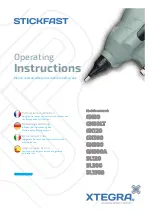
5
OpERAtION
WARNINg
Do not use oxygen, combustible gases or bottled gases
as a power source for this tool. The tool will explode and
cause death or serious injury.
WARNINg
Do not allow familiarity with tools to make you careless.
Remember that a careless fraction of a second is
sufficient to inflict severe injury.
WARNINg
Always wear safety goggles or safety glasses with side
shields when operating tools. Failure to do so could
result in objects being thrown into your eyes resulting
in possible serious injury.
WARNINg
Disconnect the tool from the air supply before leaving
the work area, moving the tool to another location, or
handing the tool to another person. Failure to do so
could result in serious personal injury.
WARNINg
Always wear eye protection. Eye protection does
not fit all operators in the same way. Make sure the
eye protection chosen has side shields or provides
protection from flying debris both from the front and
sides.
pREpARINg thE tOOl FOR UsE
See figure 1.
WARNINg
Please read and observe these operating instructions
before using the tool. Basic safety measures should
always be strictly followed to protect against damage to
the equipment and personal injury to the user or other
people working in the vicinity of operation.
Under normal use conditions, the tool should be lubricated
with air tool oil before connecting the tool to an air supply.
Add air tool lubricant into the air fitting on the tool once
daily with minimal use, or twice a day with heavy use. Only
a few drops of oil at a time is necessary. Too much oil will
only collect inside the tool and will be noticeable in the
exhaust cycle.
Before connecting the tool, check the air compressor
gauge to be sure it is functioning within the proper range
of 4.8 - 8.3 bar (70 - 120 psi).
NO-MAR pAd
See figure 2.
The no-mar pad attached to the safety yoke of the tool
helps prevent marring and denting when working with
softer woods.
WARNINg
Disconnect the tool from the air supply before removing
or replacing the no-mar pad. Failure to do so could
result in serious personal injury.
The pad can be removed by pulling it down and away from
the safety yoke. To replace the pad, fit it into place over
the safety yoke and push up at the back to reseat.
AdjUstINg thE ExhAUst
See figure 3.
The adjustable exhaust on the end cap of the tool allows
the operator to direct the exhaust according to operator
preference.
To adjust, turn the exhaust cap in the desired direction.
CONNECtINg thE tOOl tO AN AIR sUpply
See figure 4.
WARNINg
Ensure that the pressure supplied by the compressed
air system does not exceed the maximum allowable
pressure of the fastener driving tool. Set the air
pressure initially to the lower value of the recommended
allowable pressure (see Specifications).
WARNINg
Empty the magazine to prevent a fastener from being
ejected at the next stage of work in the event that
internal parts of the fastener driving tool are not in the
starting position following maintenance and repair work
or transportation.
WARNINg
Connect the fastener driving tool to the compressed
air supply using suitable pressure hose equipped with
quick-action connectors.

































